Synopsys Bundle
How Did Synopsys Revolutionize Tech?
Ever wondered how the chips inside your devices are designed? This is where Synopsys, a powerhouse in Electronic Design Automation (EDA), comes in. From its humble beginnings in 1986, Synopsys has reshaped the Synopsys SWOT Analysis landscape. Let's dive into the remarkable journey of the
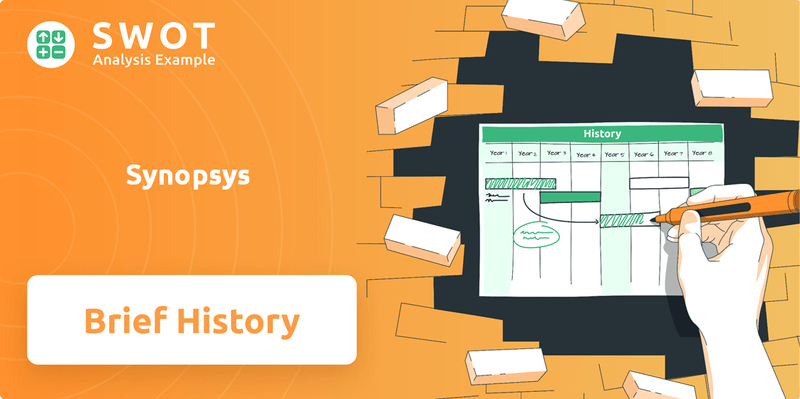
The
What is the Synopsys Founding Story?
The story of the Synopsys company began on December 18, 1986. It was founded as Optimal Solutions, Inc., in Research Triangle Park, North Carolina. This marked the start of a journey that would see the company become a key player in the EDA software market.
The founders, Aart de Geus, David Gregory, and Bill Krieger, along with contributions from Alberto Luigi Sangiovanni-Vincentelli and Bill Gibby, were engineers from General Electric's Advanced Computer-Aided Engineering Group. Their vision was to address the growing complexities in integrated circuit design.
The initial funding included a $3 million investment from Sevin Rosen Funds in 1987. This early support was crucial for the company's growth and development.
The company's early focus was on logic synthesis, a technology developed by de Geus's team. This technology allowed engineers to automate the creation of logic designs. The flagship product was Design Compiler.
- Founded on December 18, 1986, as Optimal Solutions, Inc.
- Initial focus on logic synthesis.
- Relocated to Mountain View, California, in 1987.
- Renamed to Synopsys, reflecting its core technology.
In 1987, the company moved to Mountain View, California, and was renamed Synopsys. The name, a combination of 'SYNthesis' and 'OPtimization SYStems,' clearly defined its core focus. This move to Silicon Valley was a pivotal moment, solidifying its presence in the heart of the tech industry.
Synopsys SWOT Analysis
- Complete SWOT Breakdown
- Fully Customizable
- Editable in Excel & Word
- Professional Formatting
- Investor-Ready Format
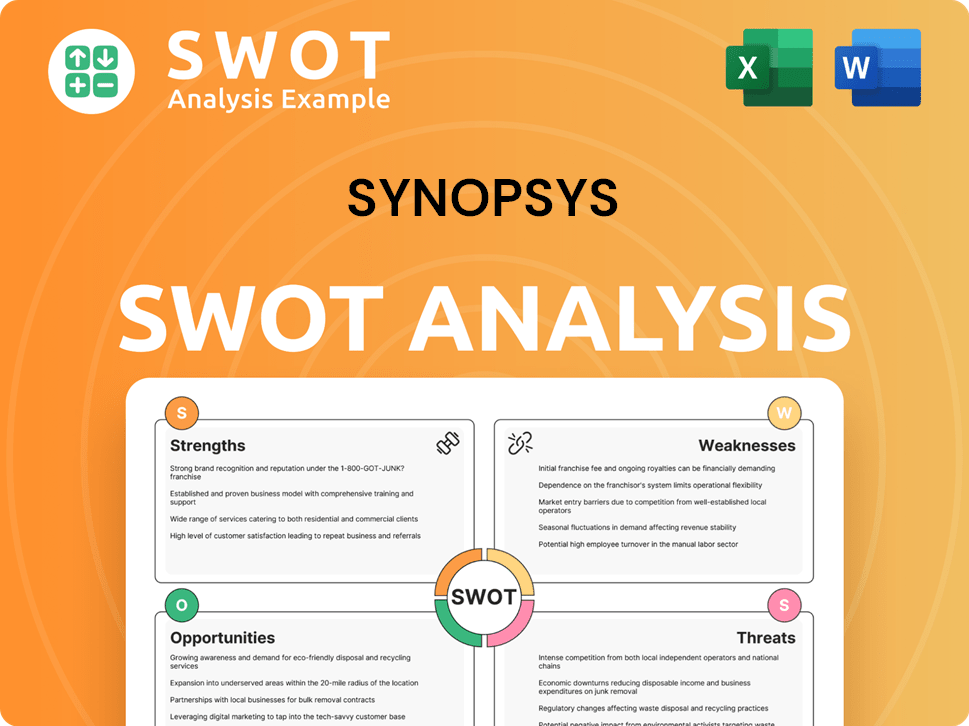
What Drove the Early Growth of Synopsys?
The early growth of the Synopsys company was marked by rapid expansion and strategic product development. After its founding in 1986 and rebranding in 1987, the company quickly established itself as a leader in logic synthesis. This period was crucial for establishing Synopsys within the semiconductor industry.
Synopsys's flagship product, Design Compiler, was instrumental in commercializing automated logic synthesis. This innovation transitioned chip design from schematic-based to language-based methodologies. This foundational technology was critical for addressing the scale and systemic complexity of modern designs.
The company's revenue grew rapidly, reaching $22 million by 1990. Synopsys went public with an initial public offering (IPO) in February 1992, a significant milestone that provided capital for further expansion. The Synopsys IPO date marked a pivotal moment in its growth trajectory.
By 1994, Synopsys acquired Logic Modeling for approximately $118 million through a stock transaction, expanding its offerings into simulation and verification. In 1997, it acquired EPIC Design Technology and Viewlogic Systems for approximately $1 billion. These Synopsys acquisitions significantly enhanced its place and route capabilities.
Synopsys broadened its product portfolio and market reach through strategic acquisitions and partnerships. Early on, Synopsys recognized the importance of integrating EDA software and IP. The company's tools quickly broadened to encompass front-end design, including simulation, timing, power, and test, as well as system-level design and physical implementation. For more details on its business model, see Revenue Streams & Business Model of Synopsys.
Synopsys PESTLE Analysis
- Covers All 6 PESTLE Categories
- No Research Needed – Save Hours of Work
- Built by Experts, Trusted by Consultants
- Instant Download, Ready to Use
- 100% Editable, Fully Customizable
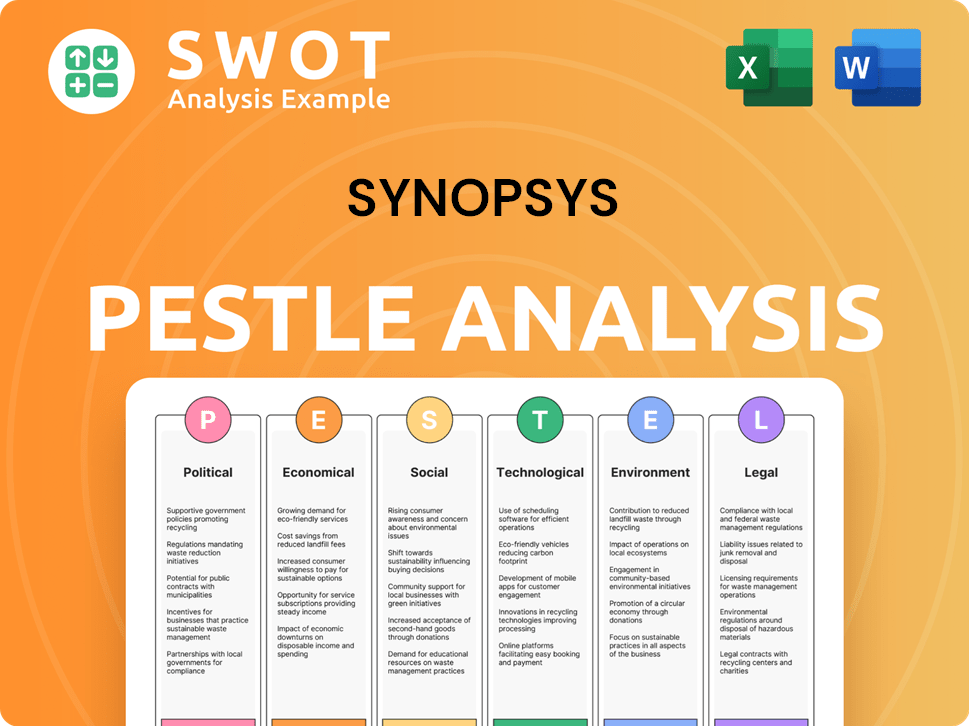
What are the key Milestones in Synopsys history?
The journey of Synopsys, a prominent player in the semiconductor industry, is marked by significant Synopsys key milestones, strategic innovations, and the navigation of various challenges. From its inception, Synopsys has consistently evolved, adapting to the dynamic needs of the electronic design automation (EDA) landscape and the broader tech industry. Understanding the Synopsys company's trajectory offers insights into its resilience and strategic foresight.
| Year | Milestone |
|---|---|
| 1986 | Founding of Synopsys, marking the beginning of its journey in the EDA sector. |
| Early 1990s | Pioneered design-for-test products and the DesignWare methodology, enhancing design reuse. |
| 1994 | Acquired Logic Modeling, expanding into simulation and verification. |
| 1997 | Acquired EPIC Design Technology and Viewlogic Systems, broadening its product offerings and customer base. |
| 2002 | Acquired Avant! Corporation, strengthening its portfolio in physical design and verification. |
| 2006 | Built a supercomputer using commodity Linux servers to develop and run computationally intensive EDA applications. |
| 2023 | Launched Synopsys.ai Copilot in collaboration with Microsoft, integrating AI into EDA tools. |
| September 2024 | Completed the sale of its Software Integrity business for up to $2.1 billion. |
Synopsys's commitment to innovation is evident in its pioneering work in logic synthesis, which transformed chip design. The introduction of its flagship Design Compiler tool was a game-changer, enabling more complex designs and boosting productivity. Furthermore, the company has continually integrated advanced technologies, such as AI and machine learning, into its EDA software to enhance performance and efficiency. This dedication to innovation continues to drive Synopsys software products and maintain its competitive edge.
Synopsys revolutionized chip design by commercializing logic synthesis technology.
The introduction of the Design Compiler tool was a significant advancement in EDA.
Synopsys pioneered design-for-test products, enhancing the reliability of chip designs.
The DesignWare methodology facilitated smart design reuse, improving efficiency.
Synopsys has integrated AI and machine learning into its EDA tools.
Launched Synopsys.ai Copilot in collaboration with Microsoft to accelerate chip design.
Synopsys has faced challenges, including competitive pressures from other EDA software vendors. In 1992, an alliance of competitors challenged Synopsys's market leadership. The company's strategic responses, such as expanding into software integrity and the planned acquisition of Ansys, demonstrate its adaptability. For more insights, you can explore the Growth Strategy of Synopsys.
In 1992, Synopsys faced competition from an alliance of synthesis vendors.
Despite challenges, Synopsys maintained its market leadership through innovation and strategic moves.
Synopsys expanded into software integrity through acquisitions like Coverity and Black Duck Software.
The planned acquisition of Ansys for $35 billion aims to expand Synopsys's presence in simulation software.
The sale of the Software Integrity business for up to $2.1 billion allows Synopsys to concentrate on its core EDA business.
Synopsys continues to make strategic moves to adapt to market dynamics and technological advancements.
Synopsys Business Model Canvas
- Complete 9-Block Business Model Canvas
- Effortlessly Communicate Your Business Strategy
- Investor-Ready BMC Format
- 100% Editable and Customizable
- Clear and Structured Layout
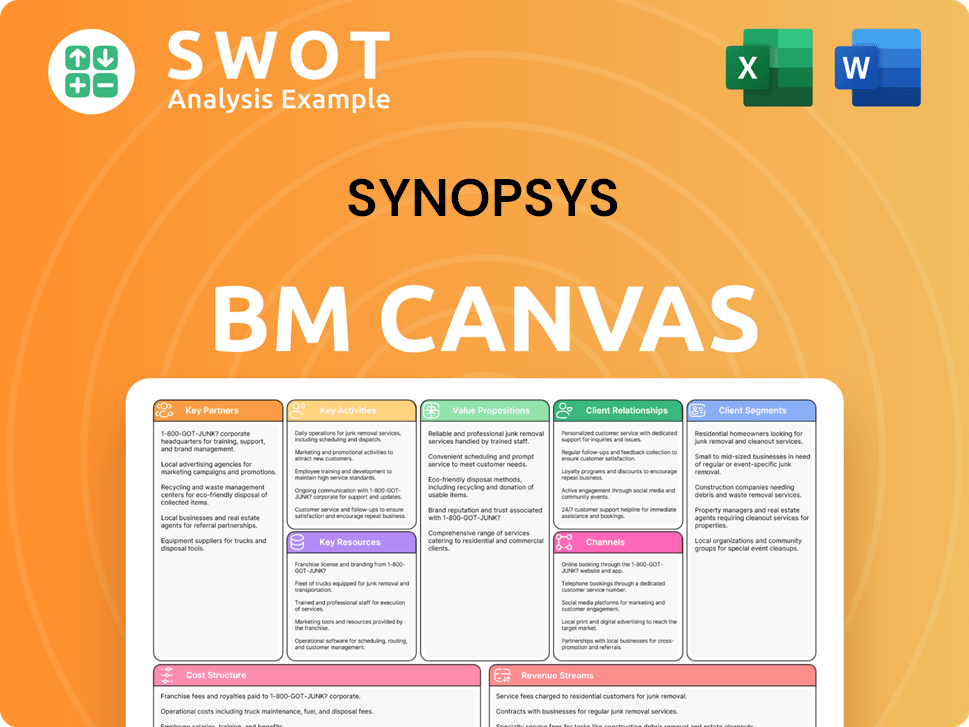
What is the Timeline of Key Events for Synopsys?
The Synopsys company has a rich history, evolving from a startup to a leader in the Electronic design automation (EDA) software industry. The Synopsys history is marked by strategic acquisitions, technological innovations, and a consistent focus on supporting the semiconductor industry.
| Year | Key Event |
|---|---|
| 1986 | Founded as Optimal Solutions, Inc. in Research Triangle Park, North Carolina. |
| 1987 | Renamed Synopsys and moved to Mountain View, California. |
| 1990 | Introduced test synthesis products. |
| 1992 | Completed initial public offering (IPO). |
| 1994 | Acquired Logic Modeling, expanding into simulation and verification. |
| 1997 | Acquired EPIC Design Technology and Viewlogic Systems for approximately $1 billion, enhancing capabilities and customer base. |
| 2002 | Acquired Avant! Corporation, strengthening physical design tools. |
| 2006 | Built a supercomputer using commodity Linux servers for EDA applications. |
| 2008 | Acquired Synplicity for $227 million, enhancing FPGA synthesis. |
| 2012 | Acquired SpringSoft and Magma Design Automation, expanding emulation and custom design capabilities. |
| 2015 | Acquired Coverity, expanding into software quality and security testing. |
| November 2023 | Launched Synopsys.ai Copilot in collaboration with Microsoft, leveraging large language models for chip design. |
| January 2024 | Sassine Ghazi succeeded Aart de Geus as CEO, with de Geus becoming Executive Chair. |
| January 2024 | Announced intent to acquire Ansys for $35 billion. |
| September 2024 | Completed the sale of its Software Integrity business for up to $2.1 billion. |
Synopsys is strategically positioned for continued growth, driven by trends like AI and software-defined systems. The company is focused on expanding its IP portfolio, particularly in high-growth areas such as automotive and IoT. The pending acquisition of Ansys, expected to close in the first half of 2025, will significantly broaden its presence in simulation software.
The company anticipates double-digit revenue growth for fiscal year 2025, with projected revenue between $6.745 billion and $6.805 billion. Synopsys aims for industry-leading double-digit revenue growth and mid-40s non-GAAP operating margins. The sale of the Software Integrity business for up to $2.1 billion is also a key financial move.
Synopsys continues to leverage AI and machine learning within its EDA tools for more efficient design processes. The launch of Synopsys.ai Copilot demonstrates its commitment to innovation. The company's strategic initiatives emphasize solving engineering challenges from silicon to systems, aligning with its founding vision.
With Sassine Ghazi as CEO, Synopsys is poised to maintain its leadership in the EDA software market. The company's focus on solving complex engineering challenges and its strategic acquisitions have solidified its position. Synopsys' ongoing innovation and market adaptability are key to its continued success.
Synopsys Porter's Five Forces Analysis
- Covers All 5 Competitive Forces in Detail
- Structured for Consultants, Students, and Founders
- 100% Editable in Microsoft Word & Excel
- Instant Digital Download – Use Immediately
- Compatible with Mac & PC – Fully Unlocked
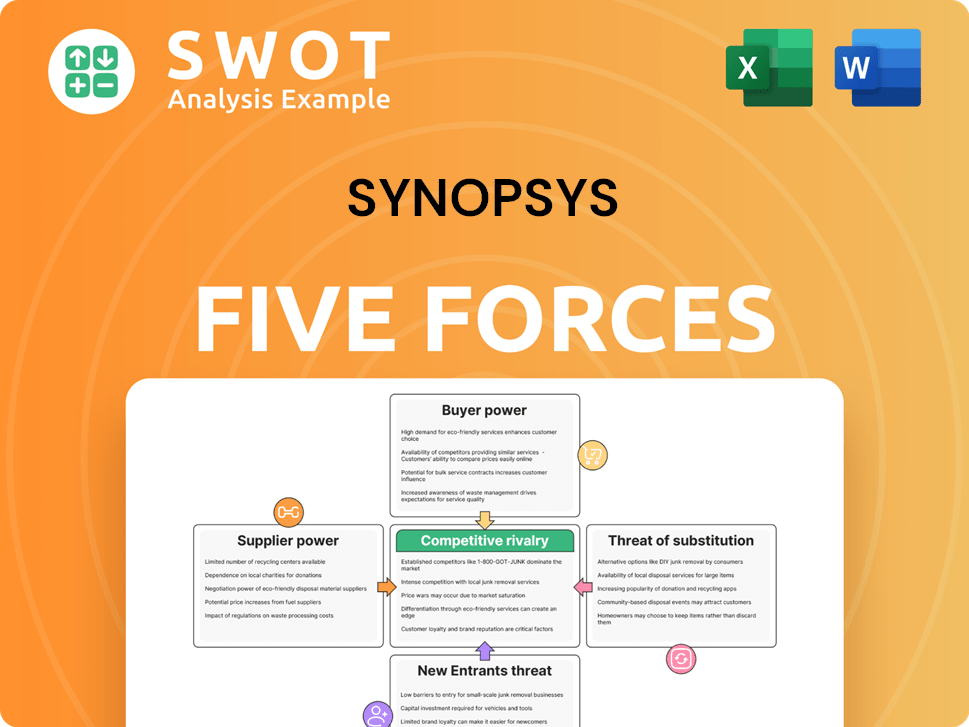
Related Blogs
- What is Competitive Landscape of Synopsys Company?
- What is Growth Strategy and Future Prospects of Synopsys Company?
- How Does Synopsys Company Work?
- What is Sales and Marketing Strategy of Synopsys Company?
- What is Brief History of Synopsys Company?
- Who Owns Synopsys Company?
- What is Customer Demographics and Target Market of Synopsys Company?
Disclaimer
All information, articles, and product details provided on this website are for general informational and educational purposes only. We do not claim any ownership over, nor do we intend to infringe upon, any trademarks, copyrights, logos, brand names, or other intellectual property mentioned or depicted on this site. Such intellectual property remains the property of its respective owners, and any references here are made solely for identification or informational purposes, without implying any affiliation, endorsement, or partnership.
We make no representations or warranties, express or implied, regarding the accuracy, completeness, or suitability of any content or products presented. Nothing on this website should be construed as legal, tax, investment, financial, medical, or other professional advice. In addition, no part of this site—including articles or product references—constitutes a solicitation, recommendation, endorsement, advertisement, or offer to buy or sell any securities, franchises, or other financial instruments, particularly in jurisdictions where such activity would be unlawful.
All content is of a general nature and may not address the specific circumstances of any individual or entity. It is not a substitute for professional advice or services. Any actions you take based on the information provided here are strictly at your own risk. You accept full responsibility for any decisions or outcomes arising from your use of this website and agree to release us from any liability in connection with your use of, or reliance upon, the content or products found herein.